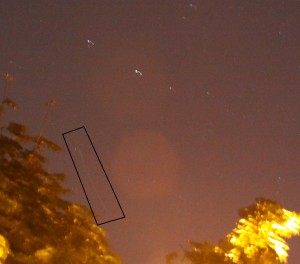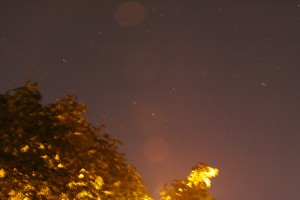by Astrogator Mike | Sep 27, 2011 | General Comments
A twitter friend @musicscott emailed me a picture he had taken Friday night of a region of the sky near Ursa Minor. In his picture he had a streak that he thought may have been a piece of the UARS satellite.

Streak near Ursa Minor provided by @musicscott
He provided me with the original as well:

The second image is really interesting, because it shows us the entire “little dipper” so we can really get a feel for where happened. Note that there’s some “jiggle” in the star images because Scott didn’t have time to set the timer on his camera, he had to hit the button manually and that shakes things a bit.
As it turns out, Scott knew very precisely when he took the picture (4:17:11 UTC), so with his help I looked into it. He gave me his precise location and time and managed to get a whole constellation into the picture. Here’s the email I sent him when I figured out what he had seen..
(more…)
by Astrogator Mike | Sep 25, 2011 | General Comments
I’ve seen lots of hocus-pocus out there on where the UARS spacecraft re-entered. Lots of bogus videos are out along with vague descriptions of where the spacecraft landed (some that narrow it down to the Pacific Ocean). While NASA’s taking their time giving us an impact point, they are giving us enough information to calculate one ourselves. Thus, I will take the liberty of doing so. I’ll say a few things about it and then take a wild flying guess (WFG) at where it hit in the ocean based on the few pieces of information we do have.
(more…)
by Astrogator Mike | Sep 24, 2011 | General Comments
I wanted to revisit the previous post, describing a near miss of ISS I witnessed back in August. Recall that both my brother and I saw the same 2 satellites cross in the sky at the same time.
First, let’s just take a look at the geometry that allows satellites to be seen in the first place. If you’re going to see a satellite from the ground, it needs to be lit (by the sun) and you need to be in shadow (night). Here’s a picture of the geometry from my location on Aug. 29, 2011.

Orbit Geometry and Earth Shadow for an ISS pass on Aug. 29, 2011
The red cylinder off to the right is the shadow, the Sun is off to the left. A little closer look allows us to see what’s happening. The two satellites (ISS in the blue, SL rocket body in the red) have orbits that are above the shadow. Note that Friday Harbor and Seattle are both in darkness.
(more…)
by Astrogator Mike | Aug 30, 2011 | General Comments
Is it possible that my brother and I simultaneously witnessed a potentially deadly close approach of the International Space Station from the ground? It’s not clear, but it has been interesting putting together the evidence.
I live north-northwest of Seattle, WA. in Friday Harbor, on San Juan Island (in the US). On Sunday the 28th of August, I saw an ISS pass from my house that started at 21:02 Local (Aug 29 2013 4:02 UTC). Prior to the beginning of the pass, I had called my brother who lives down in Seattle (about 65 miles as the crow flies). He hadn’t seen an ISS pass before, and this one looked to be pretty bright (-3.5 mag, according to the Heavens Above website). He called me on his cell phone during the pass, and we talked as we watched it. Near the end of the pass, I saw another satellite come from the north, and appear to run right through the ISS. My brother noted the same thing to me on the phone, wondering out loud if “someone is trying to shoot it down”. He was joking, but that is what it looked like from our different vantage points.
(more…)
by Astrogator Mike | Jun 25, 2011 | General Comments

IBEX Earth-Moon Rotating Frame 10-year Trajectory
John and I tried to get the IBEX folks to go for this in 2007, but it was too late in the game to change the science orbit. After 2.5 years of nominal ops (and a whole lot of analysis by John and his team at Applied Defense Solutions) the IBEX science team decided to go for it and use a 3:1 Lunar resonant orbit. A 3:1 Resonance, of course, means simply that IBEX orbits 3 times for every Lunar orbit. There are some very nice things about this, the first being that you can keep apogee away from the Moon, and prevent Lunar perturbations from driving your perigee into the Earth. You can also keep the geometry of the orbit constant with respect to the ecliptic and keep Earth shadows off the orbit for most of the time. John will come back later with pictures and some more details. It really is a neat orbit. My good friend Chauncey Uphoff used to love to talk about resonant orbits and all their uses. He’d love this!
This animation shows the IBEX orbit in an Earth-Moon rotating frame. The Moon is at the top, Earth in the Middle. Note that the Apogees are away from the Earth-Moon line.



